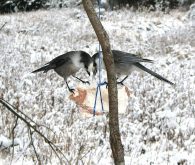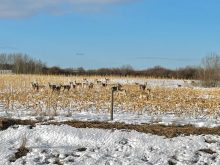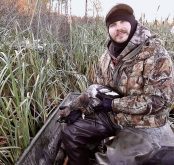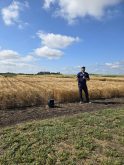The predators haven’t gone away, but the livestock industry now has better ideas on how to handle them.
The Livestock Predation Prevention Pilot, Manitoba’s three-year examination of its predator loss problem, is over. Prevention strategies have been tested, reports sent, and every resulting bit of advice has been made available in print and video form on the Manitoba Beef Producers website.
Why it matters: The pilot program started in 2020 after years of producer calls for action.
Read Also

New ranking elevates Assiniboine College to national research elite
Brandon’s Assiniboine College is 47th in a national ranking measuring research dollars and output at publicly funded institutions in Canada.
Predation has been a perennial thorn in the side of livestock producers, particularly in the Interlake and Parkland. MBP’s general meetings in 2018 and 2019 saw producers report up to 10 per cent losses, as well as indirect losses from increased abortions, which they attributed to animal stress.
Producers have continually called for changes to insurance and for more resources to remove problem predators.
In 2020, they got some good news. A dedicated pilot project would launch, empowered to source and test things like predator-resistant fencing and provide a report . It was a combined effort between MBP, Manitoba Agriculture, the Manitoba Agricultural Services Corporation, Agriculture and Agri-Food Canada, Manitoba Trapper’s Association and Manitoba Sheep Association.
The project would also attempt to gauge the depth of the problem. A survey in the opening year saw 556 producers report 11,606 animals lost over a five-year period. Coyotes accounted for 62 per cent of kills. Between 2015 and 2019, MASC reported 7,675 cattle and 2,177 sheep lost.
What works
Project lead Ray Bittner said he’s generally happy with results of the project.
“What we intended to do is find mitigation techniques that worked, and we did that,” he said.
The challenge is that predators deterred from one farm may easily move to another, less-protected operation.

Predator-resistant fencing was one of the winning strategies during calving/lambing and weaning, whenherds are more vulnerable and daily operations can centre on smaller, designated pens—a less financially daunting prospect than trying to fence a whole pasture. It can, for example, give sick calves time to recover rather than leaving them vulnerable to predators.
Two types of fencing, seven-strand high tensile wire and page wire with an anti-digging apron, were tested on eight farms, along with different anti-predator gate setups.
Of those farms, 87 per cent reported the addition helped protect livestock, and an equal number said they would recommend the practice and would rebuild the pen if it were damaged.
In 2021 prices, a five-acre, seven-wire fence would set a producer back about $3,648, the project determined, while page wire was considerably more expensive at $11,311 for a same-sized pen. Challenges with the seven-wire fence included grounding concerns and additional maintenance. Cost and tripping hazards were flagged for page wire fences in areas where the exterior was a high-traffic area for livestock.
The page wire must also be braced enough to withstand bear attempts to climb it, and additional measures like a hot wire along the top may be required if bears are the concern.
Gates are a potential weak point and must be similarly reinforced, project materials warn. They must be high enough to keep predators from jumping over and have similar anti-digging features, whether that’s a concrete footing or metal piping threshold and wire apron.
Composting pens
Deadstock composting pens were another big win.
“When a wild predator accesses a livestock mortality as a food source, it encourages them to revisit and spend more time in the area, increasing the vulnerability of your livestock. It can also bolster survival of their young,” said project materials.
A fenced composting pen removes that attractant.
Pens were tested on 14 farms. Of those, 11 reported no predator incursions. Only 57 per cent felt the practice helped with their predator problem, but 91 per cent said they would recommend it.
The pens are about more than predators, Bittner noted. They also check boxes for animal disease prevention and, with the materials used by the pilot, cost just over $2,500 for a 64-foot square pen.
“If you can remove a food source from the predators, you’ll have less population of predators close to you,” he said. “That’s got to be a good thing. And then the second thing is, it doesn’t share pathogens with other cattle or other sheep. It’s just a good idea to get those (carcasses) composted and out of the way.”

Surprises
Fox lights were a surprising success, Bittner noted. The solar-powered fixtures flash multi-coloured lights if predators approach at night.
“For a little tiny thing the size of a hockey puck just shining little lights at night, it’s fairly innocuous to human beings, but for some reason coyotes and wolves are afraid of them. If you only employ it for 35-40 days a year, it actually holds them back from a pen of animals.”
Exposure in a subsequent year might lessen the impact, he said, but wild predators tend to have short lifespans, which could preserve the efficacy.
The lights were installed on 14 farms, with 83 per cent of respondents saying it protected livestock and 85 per cent saying they recommend them.
Both the fox lights and fladry wire — electric polywire with flags tied at intervals — take advantage of wolf and coyote wariness of new things, though that effect will fade. Fladry wire is only meant to give respite for 30 to 90 days, enough to get through a vulnerable window such as calving.
Fladry wire rolls of 1,320 feet were tested on six farms at a cost of $1,471. About half said they felt it protected livestock.
Project materials suggest using fox lights around calving/lambing and weaning, although birth windows between September and April will likely get the most benefit. The lights do their best work at night, and there are few hours of darkness between May and August. Four fox lights cost about $660.
These avoidance strategies can be enhanced by livestock guardian animals or if humans walk the area, materials say.
Other tested strategies included veterinary inspections, game cameras and cow bells and GPS collars on either cattle or dogs. Producers flagged those for generally improved management, predation notwithstanding, but had issues with equipment failure.
Future work
Resources uploaded on the MBP website are the final word for the pilot, at least for now. Some other avenues were outside the scope or resources of the program, Bittner said.
A big one is livestock guardian animals. Project materials made several mentions of guardian animals as supplemental protection, but there were no efforts to introduce or test the practice. Guardian dogs are expensive and require training, Bittner noted, and it’s not the right fit for all farms.
“You need somebody who’s really, really committed to the concept.”
He also wishes the pilot made more progress on wolves. That predator species is particularly tricky because most interactions occur in summer when animals on pasture are more exposed and farther from home.
Trapping is another aspect that was tangential to the pilot, although some trapping schools ran in 2022.
















